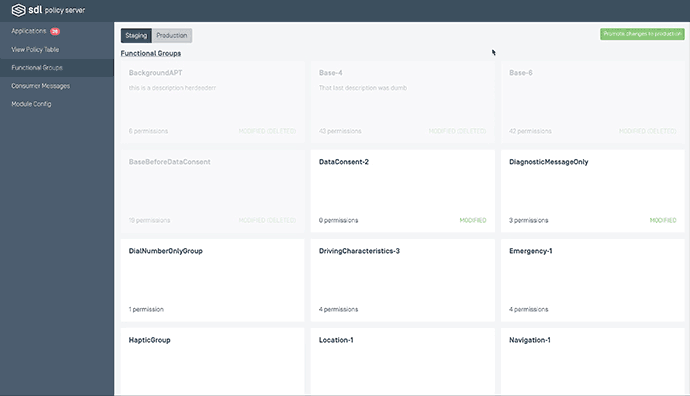Until now, managing a Policy Server required directly editing a large Policy Table JSON object or database values and familiarizing yourself with a considerable amount of behind-the-scenes technical details. To simplify the experience of Policy Server management, we're introducing a powerful front-end user interface for the open source Policy Server as of version 2.3.0. We've detailed the key components of this update below.
Application Management
Third-party apps can now be approved or denied through a review UI that includes all of the app's requested permissions. Whenever a new app is approved to support an OEM or when a previously-certified app is updated in the SDL Developer Portal, a new pending application record will automatically appear in the UI. As the OEM, you can decide to approve that version of the application, immediately making it available in your production Policy Table, or deny that application version with an optional note that includes reasons for denial. An auto-approve feature is also included via a simple toggle switch if you find it unnecessary to review a specific app for every update.

Functional Groups
Functional Groups are complex entities which ultimately provide the main functionality of a Policy Table, including permissions that apps require to operate. The new UI breaks Functional Groups down into manageable, visual components. Using the new interface, you can manage each Functional Group's associated RPCs, parameters, and more. You can even delete the pre-defined Functional Groups included with the project and/or opt to create brand new ones. All your changes are isolated to a staging Policy Table so you can preview their effect before deploying them to your production Policy Table. When you're ready to copy your Functional Group changes to production, just click the green "promote" button in the top-right of the page!

Consumer Messages
Consumer Messages are messages which may be shown to consumers from time-to-time to ask for their permission to share certain data with an application, link their personal device to the vehicle, or other situations. You can manage these messages (with different copy for different languages) and promote changes from staging to production in a similar fashion as previously described for Functional Groups.

Module Config
With the Module Config UI, you can easily change the frequency, timeout, and retry schedule of Policy Table updates. You can also define rate limits for each notification type. Like Functional Groups and Consumer Messages, these changes can be tested with the staging Policy Table, then promoted to your production policy table with the click of a button.

Policy Table Preview
While the new UI provides a visual way to manage your Policy Server configuration, we built this page to provide a simple way of previewing the automatically-generated Policy Table (sub application-specific data).

Behind-the-Scenes
We also implemented application syncing retry logic, which automatically attempts to pull application updates from SHAID using gradual back-off logic in the event that an application update notification fails to be processed correctly.
Installing/upgrading to v2.3.0
Please see our Policy Server Guides for installation and updating instructions.